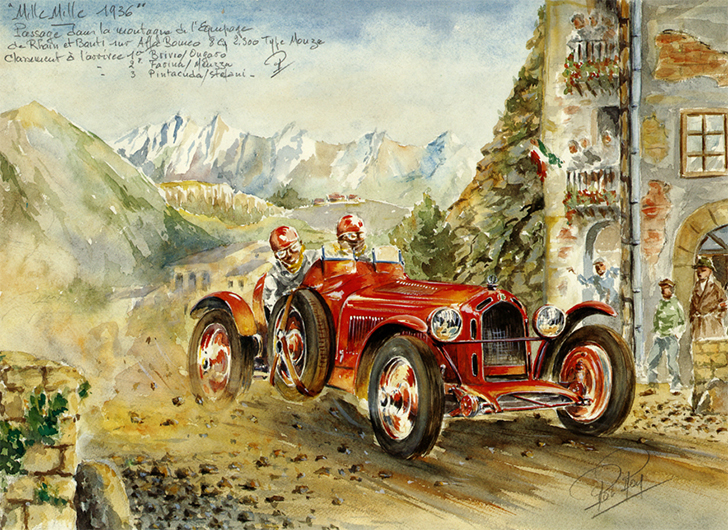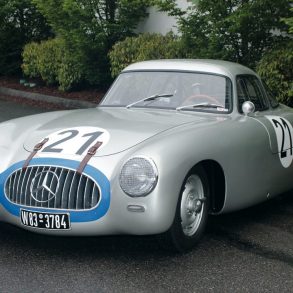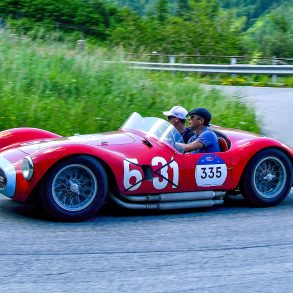Motor Racing History – Mille Miglia
Introduction
When I talk about the Mille Miglia, I feel quite moved, for it played such a big part in my life. I knew it as a driver, a team director and a constructor … and was always an admirer of its champions… In my opinion, the Mille Miglia was an epoch-making event, which told a wonderful story. The Mille Miglia created our cars and the Italian automobile industry. The Mille Miglia permitted the birth of GT, or grand touring cars, which are now sold all over the world. The Mille Miglia proved that by racing over open roads for 1,000 miles, there were great technical lessons to be learned by the petrol and oil companies and by brake, clutch, transmission, electrical and lighting component manufacturers, fully justifying the old adage that motor racing improves the breed. – ENZO FERRARI
Origins
Mille Miglia, the very words roll off the tongue and bring visions of sleek sports cars driven at fantastic speeds through small villages and along country roads, forcing their way past swarms of wasps, the countless Fiats that left the starting ramp hours before. Crowds seemingly oblivious of any danger watching the true heirs of the great city-to-city races that were run at the beginning of the 20th century.
It started out as a uniquely Italian affair, the idea originally of one man, the Conte Aymo Maggi who along with his friends, Giovanni Canestrini, Count Franco Mazzotti and Renzo Castagneto met to discuss their response to the Milanese “theft” of the Italian Grand Prix. The people of Brescia considered their town and surrounding area as the birthplace of Italian motorsport and were shocked when the 1922 Italian Grand Prix was moved to the new Autodromo Nazionale Monza and held under the auspicious of the Automobile Club of Milan.
The Italians have had a long love affair with motorsports yet at the turn of the century Italy was still primarily an agrarian society. In 1926 there were only 170,000 automobiles in the entire country, a figure exceeded by Britain’s annual production. Their drivers were still driving on the left side of the road while in town and on the right side while in the country, a fact that might not surprise a tourist who has driven in Italy lately, still it must have caused some interesting moments at the city limits.
The Fascist government of Benito Mussolini was in power and dreams of creating a new Roman Empire were about. Races in the air, on land and in the water made the front pages of leading newspapers. Races driven by the 23-year-old Aymo Maggi, scion of Brescia nobility and his equally well-endowed friend Franco Mazzotti. Together they would travel to Milan and hobnob with other young men in a hurry, the likes of Nuvolari, Borzacchini, Brilli Peri, Varzi, Danese and others.
On the evening of 2 December 1926 returning from a local hillclimb event Aymo Maggi was determined more than ever to return the glory that had been lost to their larger neighbor. Over dinner at the famous Vecchio Café in Milan with his friends Franco Mazzotti and Flaminio Monti and Renzo Castagneto he laid out his plans. After dinner they met up with Giovanni Canestrini the famous motoring correspondent for Gazzetta dello Sport. Maggi, Mazzotti, Castegneto and Canestrini, the future four Musketeers of the Mille Miglia argued into the night over the lack of sporting Italian automobiles and what could be done about it.
Believing strongly in the edict that racing improves the breed they focused on conducting a race. But not just any race, it had to be one that captured the imagination of the Italian people. Building a new circuit would appear to follow in the footsteps of their Milanese rivals. Instead, a road race was suggested, one that would start in Brescia and finish in Rome. This was quickly shouted down for a race of this type would require Brescia to share the glory with Rome. It must be remembered that Italy only became a unified country in 1861. A Roman to the sons of Brescia was only slightly less “foreign” than an American in Paris. A return trip back to Brescia solved this problem. The race would be Brescia-Rome-Brescia or approximately 1600 kilometers, to this Mazzotti is said to have exclaimed,
“That’s a thousand miles”
…and the Mille Miglia was born. The friends also decided that a new automobile club based in Brescia should be the sponsor with Castagneto responsible for overall planning and administration of the event, a position he would hold for every one of the twenty-four Mille Miglias.
Race Notes
Spectators
The Mille Miglia was a dangerous race not just for the drivers but also unfortunately fir its fans. It’s estimated that over five million men, women and children lined the route every year the race was run come rain or shine. Often it was impossible to see the way ahead and the tifosi as they were called would only jump clear at the very last moment, ‘playing chicken’ Italian style.
Most foreign drivers who competed more than once invariably commented on how much quicker they were able to drive on subsequent attempts simply due to the fact that they had become hardened to the technique of aiming their cars directly at the solid wedge of people knowing or at least hoping that the road would clear allowing them to just scrape past the outstretched arms and legs. The Conte Gastone Brilli Peri would wear a silver whistle and blow loud blasts to frighten the spectators to safety. Some of the more exuberant Italian drivers used a slightly more active form of crowd control by flicking their steering wheel to and fro causing their rear end to violently fishtail.
Donald Healey remarked:
‘I drove the whole 1,000 miles. It was quite a thing to experience…to literally be able to kill cats, dogs and even people…how awful… but with total freedom of the road. Lunatic race of course. You went through city streets that had streetcars and buses going down the centre of the road and you were obliged to cut people aside a bit!’
Practice
On one practice run Karl Kling and his co-driver Hans Klenk were exiting a long left-hand bend at close to 100 mph when they observed a Fiat 1100 that was heading straight for them, the driver evidently asleep at the wheel. With no time left to brake the Mercedes swung to the left side of the road but its rear wheel caught a tree. This threw the German car into a violent spin and it’s rear crashed into yet another tree.
After a few more slides and skids the car came to rest. After taking a deep breath the drivers realized that neither was hurt but the car was now un-drivable. Shortly afterwards Herman Lang in a sister car came upon the scene and towed the stricken car to a nearby garage. Calls were made and the 3 1/2 ton Mercedes lorry was dispatched. As the mechanics had driven a long way to meet the car Kling offered to take the wheel of the lorry. Naturally he practiced the remainder of the route racing the lorry to the consternation of the mechanics who found themselves prisoners of this maniac!
The Route
Tazio Nuvolari told his friends that he felt driving in the Mille Miglia was like drinking an exotic cocktail:
‘You might not be able to name all of the ingredients, but once you have sampled it, you could never forget the taste.’
Race
Oliver Merlin, biographer of Juan-Manual Fangio set off for the Apennines to view the race;
“The first distant roar, still miles away, caused a commotion all around. It was an intense vibration with a note that may have changed but never reduced in volume, then suddenly amidst cries from the crowd, a long steel torpedo leapt over the crest which towered above us. We saw it rushing smoothly round 500 yards pf hairpins, then it disappeared. Five seconds later at the hump under which I was crouching, it showed me its sinister snout, as it snaked round four lower hairpins …”
Earl Howe in the 1933 Mille Miglia recalls the many railway level crossings that were not sign posted and one in particular.
“With Hamilton, I came across one of these in the dark and the gates were closed. Crash! The horrifying sound of splintering timbers. Were we hors de combat? Had all our plans been spoiled? No – we had broadsided into the gates and very little damage had been done. A little later, we were racing for dear life to remove our car from the permanent way, for at any moment a train might dash down upon us. We had to turn on to the railway tracks to avoid disaster, and there we were crashing and bumping among the rails and sleepers. The train loomed round the curve. Imagine our feelings with that snorting monster roaring down on us and threatening destruction. Somehow or other we half dragged, half lifted the car out of the way. We were saved by that narrow margin which is often called a hair breadth”.
Conte Aymo Maggi

Baccoli, the one-legged chauffeur, would assemble the stable of six cars in a row on the vast gravel courtyard. The garage was methodically arranged like a racing pit and along the walls hung photographs and withered laurel wreaths, commemorating the many races Maggi and Baccoli had driven together. They had crashed in one of them and Baccoli had lost a leg and so the benevolent Conte Maggi had ensured the trusted mechanic’s future by giving him a job as his driver. Each car was washed and polished and lined up with engines running while the family was at breakfast. When the Conte was ready to leave he would rush into the courtyard followed by the Contessa, Ernesto and an excited pack of dogs. Screaming last minute instructions for the day to all and sundry, he would solemnly inspect the cars like a general on parade. With Baccoli hovering in the background the Conte would eventually say, ‘Today I will drive the Alfa.’ With that he would leap into the car and accelerate violently out of the courtyard, leaving the fumes of racing oil lingering in the air and a cloud of dust settling on the bemused house-guests – and Baccoli with five more cars to wash.















